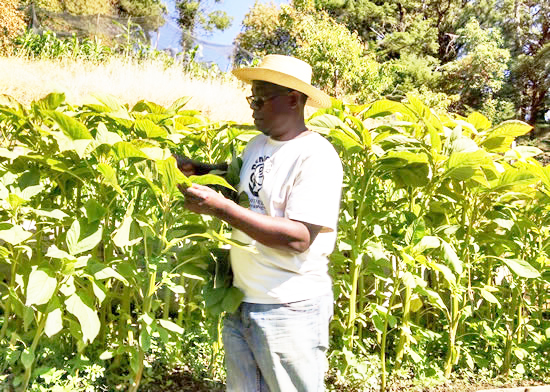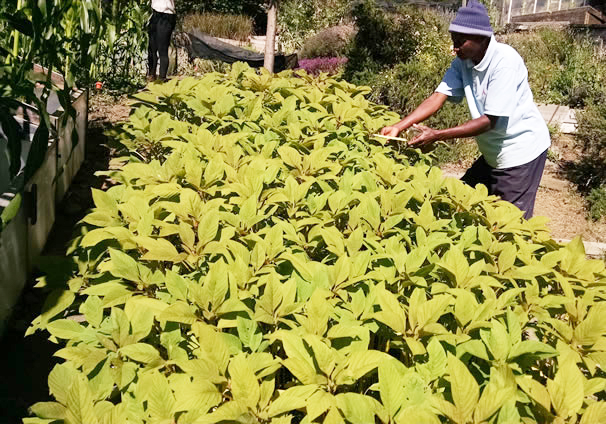The Jeavons Center Mini-Farm Garden Report
Experiments: Rice Research and Plant Spacing
By Jes Pearce, The Jeavons Center Mini-Farm Manager

Jean observes amaranth growth
PHOTO CREDIT: JES PEARCE
The interns are back! After taking a "growing season" in 2015 from the internship to expand and refine our curriculum, we now have the wonderful opportunity to enact all of our great revisions with our current interns. And what a great group of interns we have this year! There is a wide range of skills and experience among them that inspires creativity and curiosity within the garden. We function as a melting pot, able to explore and learn alongside one another's skill sets through the context of GROW BIOINTENSIVE Sustainable Mini-Farming. All of this energy, experience and curiosity have led to questions. And when we have questions we love to experiment!
One of our interns here at The Jeavons Center, Jean Apedoh, is an expert teacher of the System of Rice Intensification (SRI) in Togo. So when he arrived, he was ready to grow rice using the GB method. However, the Willits climate is non-optimal for growing rice. Rice is a heat lover and with our cold nights it is hard to get enough heat units to have it grow to maturity. But with Jean's drive and experience we decided to go for it! We researched together and found an upland rice variety called Duborskian, bred in Russia and hardy for cooler weather. We read in multiple books about best practices for starting rice in a greenhouse to gain extra heat units and let the plant get bigger before it goes out into the cooler nights. We also soaked the rice in water for 72 hours to increase germination and flatted it on April 17th. We planted the rice on May 13th and covered it with a mini-greenhouse. And it grew! Jean then taught me the importance of cultivating the rice to add air to the soil. While rice is able to grow submerged in water, the SRI tests conducted around the world have shown significantly healthier root systems, and in turn plants, when exposed to air. He also taught me about strategic watering of rice during different phases of its life to maximize tillering and seed production. The rice has set its seed but not yet matured. I have been told that this variety of rice has a very rich and nutty flavor. We look forward to a bountiful rice harvest soon!
Another intern Milesh, from Kenya, is leading a spacing trial experiment with amaranth this year. He planted amaranth on 4-, 6-, 9-, and 12-inch centers. This experiment allows us to explore the most optimal spacing for amaranth to get the highest yield of both biomass and seed. Results to come!
As a group we decided to do an experiment with direct-sown beans versus transplanted beans. How much water can we save when we start beans in a flat versus directly in the bed?? We used 55 gallons of water over 7 days in the direct-sown beds versus only 3.5 gallons over 7 days in the flats. It took 15 times more water in the bed, that's a lot!!
Though these experiments may seem small, it is through these continued efforts that we not only empower the interns to run their own experiments in the future but we do it using low-technology and low-cost techniques. We also inspire a deeper understanding of the success of the GB method. Seeing is believing and as each of our interns explores and experiments with GB, we are all able to develop a deeper understanding of its success.
So my friends, when you have a question or an idea, I encourage you to become a scientist right in your own backyard! Happy experimenting!

Milesh measures amaranth leaves in the spacing experiment
PHOTO CREDIT: JES PEARCE
top | Newsletter Home | Article Index | Archive

|




